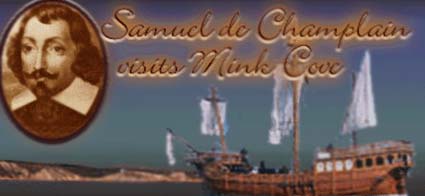
 |
|

In
the spring of 1604, while looking for a suitable place for settlement, Samuel
de Champlain landed at Cape Fourchu (Yarmouth). He described this
port as a good one for vessels at its entrance, but at its head it dried up
almost completely at low tide. There Champlain and his crew enjoyed excellent
cod fishing.
From that point they set sail northward looking for another harbor.
Along the way he described seeing a number of coves with soil that seemed
suitable for cultivation. He found the coast very clear, without
islands, rocks or shoals, and in his opinion it was quite safe for ships.
Not far offshore they visited an island called Long Island which
has a passage into the great French Bay (later named Bay
of Fundy). He found the island to be covered in great numbers
of pine and birch trees, and the shore to be bordered with many dangerous rocks.
He decided there were no suitable places for vessels except for a few
little shelters at the end of the island and three or four rocky islets where
Natives would capture seals. He
wrote of the great tides, especially at Petit Passage,
which he felt was a very dangerous place for ships.
From Long Island he sailed north-east and found a cove (now Mink
Cove) where ships could anchor safely. He found the bottom to be only
mud and the shore was completely bordered by very high rocks. There was
also a very good silver mine that turned out to be galena, (an ore made of lead,
often mistaken for silver ) which is of little value.
Further up the coast they found a river named Du Boulay (now Little
River), where the tide ran quite far up onto the land. Du Boulay was
a member of Montsí expedition and later became Champlainís brother-in-law.
As they continued on they found a good harbor for vessels and
an iron mine, which was estimated to yield fifty percent iron for each measure
of ore. This harbor is now called Sandy
Cove, and the iron mine is on the St. Maryís
Bay shore near Sandy Cove.
They continued on their journey and came upon anther iron mine, near which was a river bordered by meadow. The soil he described was red like blood. This is now called Waterford.
Samuel de Champlain and his crew continued on their journey and eventually settled at Port Royal around the Annapolis Basin in 1605.